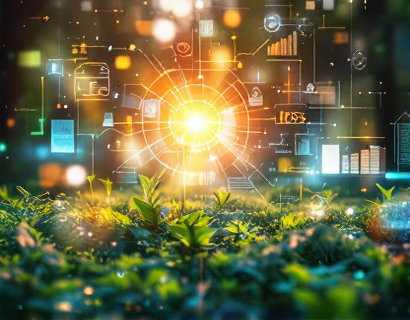Maximizing Yields and Sustainability in Horticulture with Advanced Environmental Analytics
In the realm of horticulture and agriculture, the pursuit of maximizing yields while maintaining sustainability is a complex challenge that requires innovative solutions. Advanced environmental analytics emerges as a pivotal tool in this endeavor, offering data-driven insights that optimize resource management and enhance crop productivity. This article delves into how leveraging sophisticated environmental analytics can transform horticultural and farming operations, leading to more efficient use of resources, higher crop yields, and a healthier planet.
The integration of advanced environmental analytics into horticulture and farming operations represents a significant leap forward in agricultural technology. By harnessing vast amounts of data from various sources such as soil sensors, weather stations, and satellite imagery, farmers and horticulturists can gain a comprehensive understanding of the environmental conditions affecting their crops. This data-driven approach enables precise decision-making, reducing waste and increasing efficiency.
Understanding Environmental Analytics in Horticulture
Environmental analytics involves the collection, analysis, and interpretation of environmental data to inform agricultural practices. In horticulture, this includes monitoring soil moisture levels, nutrient content, temperature, humidity, and light exposure. By continuously tracking these parameters, growers can identify optimal conditions for plant growth and detect potential issues before they become critical.
The use of sensors and IoT devices plays a crucial role in environmental analytics. Soil moisture sensors, for instance, provide real-time data on soil hydration levels, allowing for precise irrigation scheduling. This not only conserves water but also ensures that plants receive the exact amount of moisture they need, promoting healthy growth and higher yields. Similarly, temperature and humidity sensors help in creating microclimates within greenhouses, enabling the cultivation of a wider range of crops regardless of external weather conditions.
Resource Efficiency Through Data-Driven Decision Making
One of the primary benefits of advanced environmental analytics is the enhancement of resource efficiency. By analyzing data from various sources, farmers can optimize the use of water, fertilizers, and pesticides. For example, precision irrigation systems can be calibrated based on real-time soil moisture data, ensuring that water is applied only when and where it is needed. This reduces water wastage and minimizes the risk of over-irrigation, which can lead to soil erosion and nutrient leaching.
Fertilizer management is another area where environmental analytics can significantly improve efficiency. Soil nutrient sensors can detect the exact nutrient levels in the soil, allowing for targeted applications of fertilizers. This precision reduces the overuse of chemical inputs, lowering costs and minimizing environmental pollution. Moreover, by understanding the specific nutrient requirements of different crops and growth stages, farmers can tailor their fertilization strategies to maximize yield while minimizing waste.
Enhancing Crop Yields with Advanced Analytics
Higher crop yields are a direct result of optimized environmental conditions and resource management. Advanced environmental analytics provides the insights necessary to create ideal growing conditions for each crop variety. For instance, by monitoring light exposure, growers can adjust shading systems in greenhouses to ensure that plants receive the optimal amount of sunlight, promoting photosynthesis and growth.
Temperature and humidity control is equally important. By maintaining optimal temperature ranges and humidity levels, plants can thrive, leading to faster growth cycles and higher yields. Environmental analytics can also help in predicting and mitigating the effects of extreme weather events, such as heatwaves or frosts, by providing early warnings and recommendations for protective measures.
Promoting Sustainable Practices
Sustainability is a core principle in modern horticulture and agriculture. Advanced environmental analytics supports sustainable practices by reducing the environmental footprint of farming operations. For example, precise application of water and fertilizers not only saves resources but also reduces the risk of chemical runoff into waterways, protecting ecosystems and biodiversity.
Additionally, environmental analytics can aid in the adoption of regenerative agriculture practices. By monitoring soil health and microbial activity, farmers can implement practices that enhance soil fertility and structure, such as cover cropping and reduced tillage. These practices improve soil carbon sequestration, reduce erosion, and promote a resilient agricultural system.
Case Studies and Real-World Applications
Several case studies demonstrate the tangible benefits of integrating advanced environmental analytics in horticulture. In one example, a greenhouse operation in a temperate region used temperature and humidity sensors to create a controlled growing environment for tropical fruits. By maintaining optimal conditions, the grower achieved a 30% increase in yield compared to traditional methods. Moreover, the precise control of environmental factors reduced energy consumption by 20%, significantly lowering operational costs.
Another case involves a vegetable farm that implemented soil moisture sensors and precision irrigation. The farm reported a 40% reduction in water usage and a 15% increase in crop yield. The data-driven approach allowed the farmer to identify and address issues such as uneven soil moisture distribution, leading to more uniform plant growth and higher productivity.
Challenges and Considerations
While the benefits of advanced environmental analytics are clear, there are challenges and considerations that must be addressed. One of the primary challenges is the initial investment in technology and infrastructure. Sensors, data processing systems, and software can be costly, particularly for small-scale farmers. However, the long-term savings in resource usage and increased yields often justify the investment.
Data management and interpretation are also critical. The sheer volume of data generated by environmental sensors can be overwhelming. Farmers and horticulturists need access to user-friendly analytics tools that can process and present data in actionable insights. Training and support are essential to ensure that users can effectively leverage these tools.
Future Trends and Innovations
The field of environmental analytics in horticulture is rapidly evolving, with ongoing innovations poised to further enhance sustainability and yield optimization. Artificial intelligence and machine learning are being integrated into analytics platforms to predict crop performance, optimize resource use, and automate decision-making processes. These technologies can analyze historical data and real-time inputs to provide predictive insights, enabling proactive management of agricultural operations.
Additionally, the development of more sophisticated sensors and monitoring devices is expanding the range of environmental factors that can be tracked. For instance, new sensors can measure soil pH, electrical conductivity, and even the presence of specific pathogens. This granular data allows for even more precise management of growing conditions, leading to continuous improvements in crop quality and yield.
Conclusion
Advanced environmental analytics is a transformative force in horticulture and agriculture, offering a pathway to maximizing yields while promoting sustainability. By leveraging data-driven insights, farmers and horticulturists can optimize resource management, enhance crop productivity, and reduce environmental impact. As technology continues to advance, the potential for innovation in this field is vast, promising a future where agricultural practices are both highly efficient and environmentally responsible.










































